Distinctive features, agricultural techniques for the cultivation of lahenalia, recommendations for reproduction, methods of pest and disease control, interesting facts, types. Lachenalia (Lachenalia) or as it is called Lachenalia, refers to the genus of flowering plants that have one cotyledon in the embryo - they are also called monocots. They are all included in the Asparagaceae family. But according to some other data, scientists rank this plant as a member of the Liliaceae family. In conditions of natural growth, lashenalia can be found on the territory of South Africa, namely the Cape Province, and it is endemic to these places (that is, nowhere else on the planet do such plants grow in the wild). The genus reads from 65 to one hundred varieties, but in modern floriculture it is customary to grow only 15 species, on the basis of which multiple hybrid varieties have already been selected. Despite this, in culture, this exotic is a rather rare guest.
The genus Lashenalia owes its scientific name to Josef Franz von Jaken (1766-1839), a botanist from Austria who also studied chemistry and was a professor of chemistry and botany. In 1784, this scientist decided to immortalize the name of his colleague, scientist from Sweden - Werner de Lechenal (1736-1800). And therefore, you can often hear how the plant is called Lachenalia. Because of its habitat in the wild, the flower is called the “Cape primrose”.
All members of the genus have a long life cycle and are herbaceous bulbous plants. The total height of this exotic varies from 12 to 40 cm. The bulb has spherical or flattened-spherical contours, in diameter it reaches 1, 5–3 cm. From the outside it is covered with scales of white or brown color, in appearance the bulb is juicy, closed.
There are not many leaf plates on the shoots, usually only a pair of them is formed (if the variety with large flowers), but occasionally it grows up to ten units with small flowers. The foliage takes on linear, oblong-belt-like outlines. A root outlet is assembled from them. The surface on top of a dark green thick leaf is often spotty (small brown spots) or covered with warts. At the base, the leaf is covered with closed scales of a filmy appearance. The length of the leaf plate varies between 15–20 cm.
When lachenalia blooms, a cylindrical arrow is formed, which is crowned with a racemose or spike-shaped inflorescence containing 10–40 buds. The length of such a flower-bearing stem is 20 cm. If the size of the bulb is large, then up to 4 flower arrows can form from it. The outlines of the perianth are tubular at the base, and towards the apex it becomes bell-shaped and drooping, consisting of six lobes-petals. Moreover, the inner lobes are usually longer than the outer ones. The perianth itself has a varied color. There are quite bright colors here: yellow, green or red tones, often interspersed. Three pairs of stamens are formed inside the flower, their outlines are threadlike. The ovary in the buds of Lashenalia is upper, with three nests. The shape of the stigmas of the pistil is capitate. The upper flowers are often undeveloped. Flowers often have a fragrant aroma.
After flowering, the fruits ripen, which are a box with three ribs, fully ripening, it cracks at its seams, opening access to numerous small seeds. Seeds measure only 1.5 ml in diameter, their shape is flask-shaped, color is black, the surface is shiny.
It is recommended for experienced flower growers, as Lachenalia is capricious in its care. But due to the long flowering period in winter, beautiful decorative appearance, high rates of reproduction make the "Cape primrose" interesting for flora lovers.
Care and cultivation of lashenalia in indoor conditions
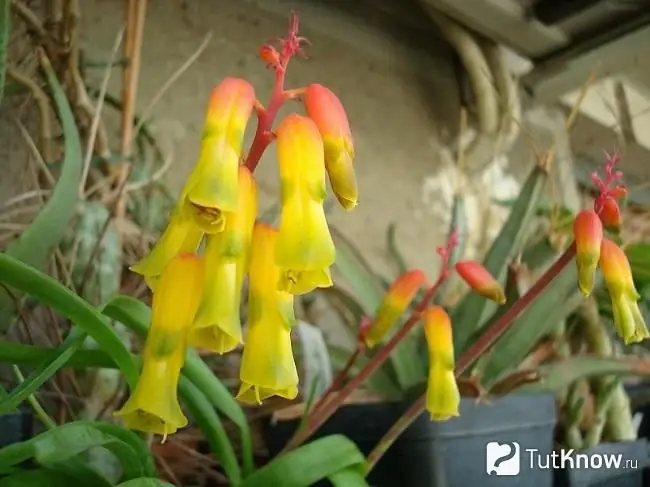
- Lighting and location selection. Cape Primrose prefers bright but diffused lighting. East or west facing windows will do.
- Content temperature. In the summer, it is necessary for the plant to arrange moderate temperatures (18-20) degrees. During the flowering period, the thermometer should fluctuate between 8-12 units.
- Air humidity when growing lachenalia, it is maintained moderate, you can sometimes spray the leaves, trying to prevent drops of moisture from getting on the flowers. You also need to wash the sheet plates with a damp soft sponge.
- Watering. When the plant enters the active phase of its growth, then it is necessary to moisten the soil in the pot moderately. Both overdrying of the substrate and its gulf are unacceptable. It is recommended to water the flower once every 1-2 weeks, with a volume of water - 1-2 cups. When the summer heat comes, the watering is slightly increased. Sometimes a crust may form on the surface of the soil, it is recommended to loosen it so that moisture reaches the roots faster. You can use sphagnum moss to mulch the soil surface in a pot of Cape primrose. If lashenalia begins to bloom, then watering is reduced. In the spring, the leaf plates of the plant begin to turn yellow and watering stops altogether. Leaves do not need to be cut until they are completely dry. During the dormant period, the bulbs should be kept practically dry.
- Fertilizers when caring for lachenalia, they are introduced during the growth and flowering period every 14 days. It is recommended to use top dressing with a high potassium content in them, there should not be much nitrogen. After the "Cape primrose" has grown pepper, it is stopped to fertilize. Since the plant is very sensitive to feeding, you must follow the dose on the package.
- Dormant period the plant begins when a few months have passed after flowering ends. Leaves wilt, watering must be reduced, and the bulbs must be kept in a well-lit and dry place.
- Transfer and selection of soil. In order for the flower to feel comfortable, it is recommended to carry out annual transplants with the arrival of autumn days. A wide and shallow container is selected. When transplanting, small baby bulbs must be carefully separated. A layer of drainage material is laid on the bottom of the new pot, this will protect the plant from soil flooding. Also, in the bottom of the new flowerpot, holes are pre-made of such a size so that the drainage does not fall out, but the excess moisture flows freely out. Plant at least 5 bulbs in a new pot.
The soil for the "Cape hyacinth" needs loose and nutritious, with good permeability to air and moisture, acidity should be in the range of pH 5, 5–7, 5. You can use ready-made soil mixtures for indoor flowering plants, or you can make them yourself. For this, the following components are connected:
- garden soil, peat, river sand (parts equal);
- sod soil, coarse sand (perlite), leaf substrate (all parts must be equal).
The transplanted plant must be placed in a cool, but well-lit place for the first time. Watering is carried out after the lachenalia shows signs of rooting.
How to propagate lahenalia on your own?
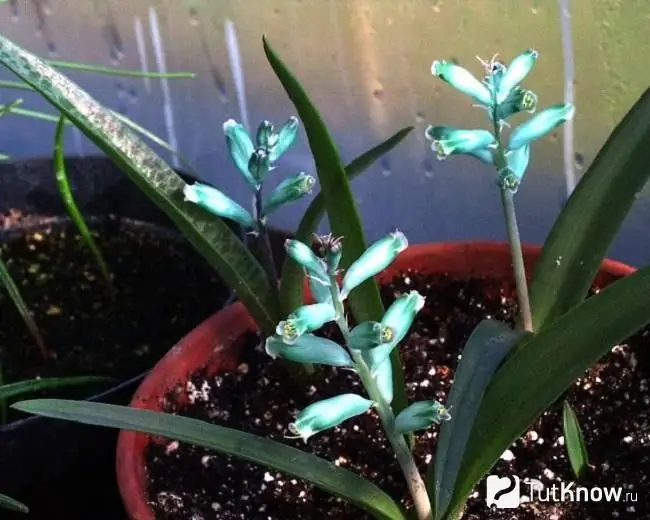
To get a new plant of "Cape primrose" sowing seed material, planting baby bulbs or performing cuttings.
Even with artificial pollination, lashenalia perfectly sets fruits filled with multiple seeds. In the inflorescence, using a soft brush, pollen is transferred from the upper flowers to the lower ones. Bolls with seeds ripen in May-June. Seed material is best used immediately after harvest, before it has lost its germination properties. When sowing seeds, the composition of the substrate is the same as when growing bulbs, but you can sow in a peat-sand mixture poured into pots. The germination temperature is maintained at about 18 degrees. All seeds are taken no closer than at a distance of 1–2 cm from each other. It is recommended to cover the container with crops with a piece of glass or plastic wrap and place it in a place with diffused lighting. It is necessary to regularly ventilate crops and moisten the soil when it dries out.
Seeds germinate after 20-30 days, while the entire part of the sprout is below the surface of the soil, and the first leaf forms immediately above the soil. After the seedlings appear, it is recommended to regularly water the young lachenelia and move them closer to intense lighting. Flowering can be expected only 2-3 years from the time of sowing.
When the bulb reaches a large size, then every year it forms small bulbous formations - children. By autumn, such small bulbs should be separated from the maternal lachenalia and planted separately in pots with a substrate or planting boxes. A container with a diameter of 10–12 cm fits 3-4 children. At first, from planting, moisture is limited, over time they increase. Such plants will bloom for 2-3 years, but this process directly depends on the size of the bulb. If it is large, then flowering can be expected in the first year.
Reproduction of "Cape primrose" is possible with the help of leaf cuttings, since they are also capable of forming baby bulbs. It is recommended to separate the stalk at the very base, so that the cut is below the ground level, and then it can be divided in half with a knife, or an incision can be made at the base. After that, the workpieces are planted in moistened sand, deepening by 2 cm. Watering is performed moderately, the pots with cuttings are kept in partial shade with diffused lighting. After a month, small onions begin to form in the cuttings, there may be 1-3 of them.
Pests and diseases in the cultivation of lahenalia
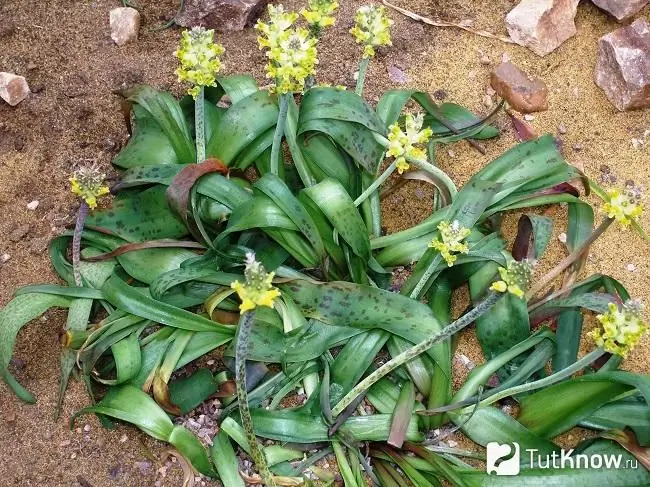
Although there is information that the plant is rarely affected by pests, it happens when the rules of keeping are violated by an attack of a spider mite, aphid or a mealybug. If harmful insects are found, it is recommended to treat with insecticidal preparations, such as "Aktara", "Actellik" or "Fitoverm", or agents with a similar spectrum of action.
When caring for lachenalia, the following troubles can be distinguished:
- if the soil in the pot is often in a waterlogged state, then rotting of the bulbs will begin;
- when the illumination level is low, and the heat indicators are high, then the shoots of the plant take on highly elongated outlines;
- if poor-quality soil was used during transplantation, then this can also provoke rotting of the roots of the "Cape primrose";
- spotting on the foliage indicates that with high humidity, lachenalia is affected by a fungal disease - it will be necessary to transplant into a looser substrate, previously disinfected;
- the cause of rotting of the bulbs can be a poorly sterilized transplant container.
Interesting facts about Lachenalia
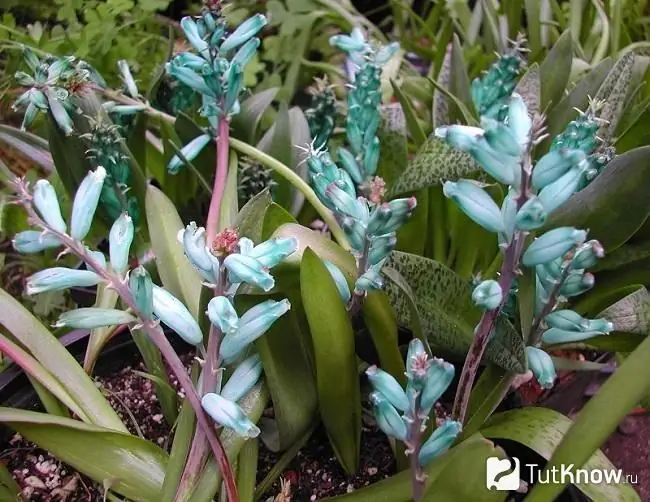
For the first time, the world got acquainted with a plant, which then did not yet have a name in 1686. His sketch was presented and published in the magazine under the patronage of the Governor of the Cape Province. The plant was subsequently identified as Lachenalia hirta. This representative of the flora was found and then collected on the Small Namaqualand plateau. All other varieties of the "Cape primrose" that were discovered later began to appear under a wide variety of generic names. For the first time from the point of view of botany, J. Murray described the lachenalia in 1784, and then in honor of the professor of botany from Sweden Werner de Lachenal, who worked at that time in Basel, Joseph Franz von Jacquin gave the name to a new exotic flower.
Types of lashenalia
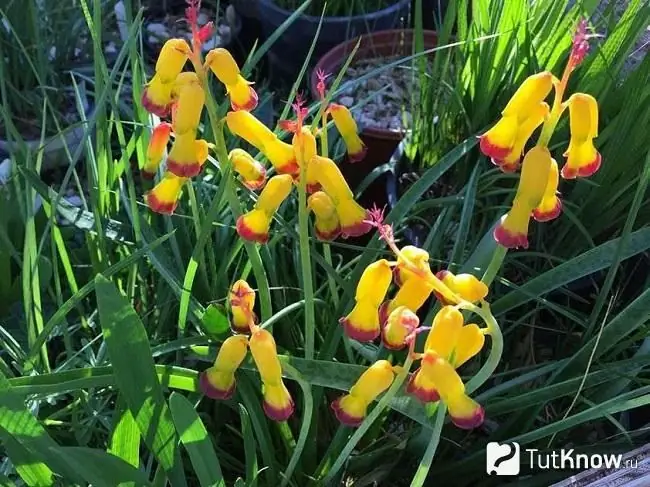
Lachenalia aloe (Lachenalia aloeides). A bulbous plant that can reach 25 cm in height. It has a pair of belt-lanceolate leaf plates, their length parameters are equal to 15–20 cm with a width of up to 4 cm. The leaf has a narrowing at the top, the surface is covered with specks. The length of the flower varies within 2–2.5 cm. Small racemose inflorescences are collected from the buds, their length is in the range of 5–10 cm. The flowers have short pedicels, their outlines are tubular. The color of the corolla petals is scarlet-red and greenish, the shape is drooping. The outer petals are usually shorter than the inner ones. The flowering process stretches over the period from January to March.
This is the most common type of lashenalia, on the basis of which hybrid forms with flowers of various colors have been derived:
- "Harlequin" has petals of a dark pink color with a yellow tone;
- Goldsonne attracts the eye with golden yellow flowers;
- "Naida" - a variety with white flowers, the eye of which casts yellow;
- "Ro" it is distinguished by a crimson corolla with a yellow tint;
- Ortenburg - flowers of a brick-red color with a salmon-yellow tone.
Bulbous Lachenalia (Lachenalia bulbifera) is found commercially under the name Bulbous Lachenalia or Lachenalia pendula. The plant is a commercial competitor to the varieties and cultivars of Lashenelia aloeidae. The plant can reach a height of 10–25 cm. It has a pair of belt-shaped lanceolate leaf plates. In length, the leaf can reach 25 cm with a width of about 4–5 cm, its surface is spotty, but the general background is dark green or purple. From the buds, racemose inflorescences are collected. The length of the bud varies within 2, 5–3, 5 cm with a width of 0.9 cm, the species is drooping. The length of the perianth lobes (external and internal) is the same. Their color is yellowish purple or bright red. But the color can also vary from orange to scarlet and crimson, and the amount of purple and green at the tips of the outer lobes also changes in color. The flowering process occurs in January-March.
The bulbs of this variety are the largest in the genus. The plant prefers to settle in natural conditions on sandy slopes and in coastal areas.
- Lachenalia contaminata is a vertically growing bulbous perennial, reaching a height of 25 cm. In nature, growth occurs in the lands of the Western Cape of South Africa. The people are called "wild hyacinth". The leaf plates have a herbaceous outline, the stems are straight and fleshy. Peduncles are crowned with narrow bell-shaped flowers of snow-white color, which are covered with maroon, reddish or brown mottling. Because of these "markers" the variety is called "contaminated". From the buds, racemose inflorescences are collected.
- Lachenalia is tiny (Lachenalia pusilla). He comes from the territories of South Africa. Has a bulb. The number of leaves varies from 4 to 6 units. They gather in a dense basal rosette, their outlines are linear, lanceolate. The surface is dense, the color can be either monochromatic (dark green) or spotted. The pedicel of this variety is quite short, so the buds seem to be hiding inside a leaf outlet. The color of the flowers is snow-white, they have a smell that vaguely resembles coconut. Ripening fruits are in the form of capsules.
What lachenalia looks like, see the video below:






